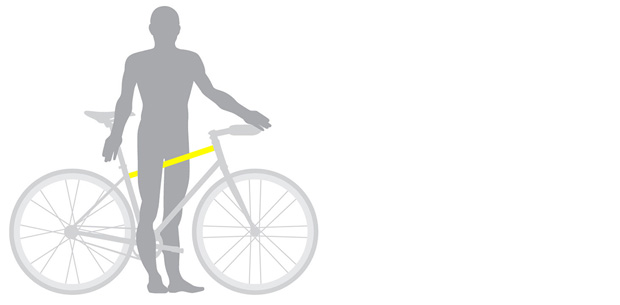
23 Nov RECOMMENDED FRAME SIZE
Proper selection of frame size is the most important decision when buying a bike because the wrong size can result in uncomfortable or unsafe driving.
In this text we will explain two methods that you can quickly and easily perform when purchasing a bike to avoid confusions or wrong choice.
Adjusting the height of the seat
This is the fastest and easiest method of finding out what is your right height of the seat. First try to exceed the top bicycle frame, if you can stand above the frame then keep on with further actions.

- Put on shoes in which you cycle
- Sit in a position as if you are driving
- Turn the pedal in its lowest position
- Make sure your leg is completely stretched
- If you can not reach the pedal then seat is too high. If the heel touches the pedal, and the leg is totally straight or slightly bent at the knee, height of the seat is right. If the heel touches the pedal and your leg is bent at the knee, seat is too low.
- Adjust the seat up or down
Now again sit on the bike and stand on the pedal with the widest part of your foot. Your leg should be slightly bent at the knee, and when you feel stable your hips may not “swing”. This is the correct position for proper and comfortable pedalling to avoid injury or pain.
Measuring internal length of the leg
This method is most accurate in determining height of the seat and frame, but requires a little more effort and help of other people, and you must have a meter and a hardback book.

- Put on pants in which you cycle
- Barefoot stand up against the wall
- Hardback book put between your legs and lift like you’re sitting in the seat bicycle
- The assistant should measure the distance of the tip of the book from the floor
- Altitude is your inner leg length (UDN)
- Multiply the length of your inner legs with 0.886 and you will get a seat height of the centre of the bottom bracket to the top of the seat, measured parallel to the seat tube
- For the size of road frame multiply your inner leg length with a coefficient of 0.663, result is your ideal frame size for road or trekking bike
- For the size of mountain bike (MTB) frame multiply your inner leg length with a coefficient of 0.225
For a sportier drive, select a smaller size frame, and for a more comfortable ride go for a larger frame, if you do not have enough time to measure and you are buying the bike online, feel free to look at our table which might help you.
Table to select the frame size for MTB bike 26 “, 27.5” and 29 “
| Driver’s height | Recommended frame size |
|---|
| Centimetres | Col (Inches) | Centimetres | Size of the bike |
|---|---|---|---|
| 148 – 155 | 13″ – 14″ | 33.0 – 35.5 | XS |
| 155 – 168 | 14″ – 17″ | 35.5 – 43.0 | S |
| 168 – 178 | 17″ – 19″ | 43.0 – 48.0 | M |
| 178 – 185 | 19″ – 21″ | 48.0 – 53.5 | L |
| 185+ | 21″ – 23″ | 53.5 – 58.5 | XL |
Table to select the frame size for road bike
| Driver’s height | Recommended frame size |
|---|
| Centimetres | Centimetres | Size of the bikea |
|---|---|---|
| 155 – 160 | 47 – 49 | XXS |
| 160 – 165 | 49 – 51 | XS |
| 165 – 170 | 51 – 53 | S |
| 170 – 175 | 53 – 55 | M |
| 175 – 180 | 55 – 57 | L |
| 180 – 185 | 57 – 60 | XL |
| 185 – 190 | 60 – 62 | XXL |
| 190 – 195 | 62 – 64 | XXXL |
Table to select the frame size for trekking bike
| Driver’s height | Recommended frame size |
|---|
| Centimetres | Size of the bikea |
|---|---|
| 150 – 160 | 42 – 47 |
| 160 – 170 | 47 – 52 |
| 170 – 180 | 52 – 54 |
| 180 – 185 | 54 – 56 |
| 185 – 190 | 56 – 58 |
| 190 – 195 | 58 – 60 |
| 195 + | 60 – 63 |
Table to select the frame size for city bike
| Driver’s height | Recommended frame size |
|---|
| Centimetres | Size of the bikea |
|---|---|
| 150 – 160 | 42 – 48 |
| 160 – 170 | 48 – 52 |
| 170 – 180 | 52 – 55 |
| 180 – 185 | 55 – 58 |
| 185 – 190 | 58 – 61 |
| 190 – 195 | 61 – 63 |
| 195 + | 63 – 66 |


Sorry, the comment form is closed at this time.